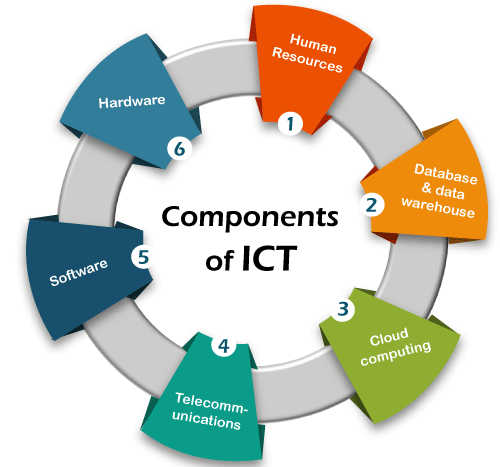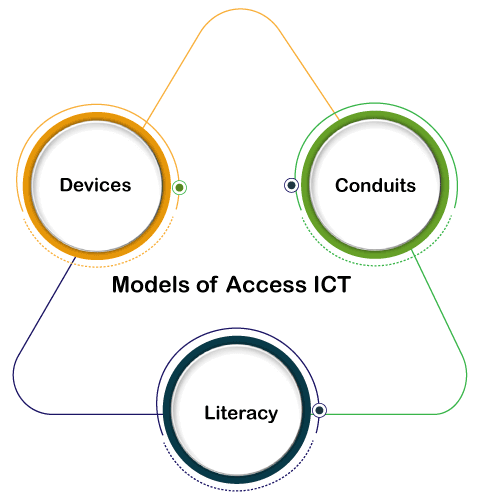What is ICT?Information and communications technology (ICT) is an extensional term for information technology (IT) which refers to the role of unified communications and the integration of telecommunications, such as telephone lines, wireless signals, and computers as well as necessary enterprise software, middleware, storage and audiovisual that enable users to access, store transmit and manipulate information in a digital form. The term ICT is also used to refer to the convergence of audiovisual and telephone networks with computer networks through a single cabling or link system. There are large economic incentives to merge the telephone network with the computer network system using a single unified system of cabling, signal distribution, and management. ICT is an umbrella term that includes any communication device, encompassing radio, television, cell phones, computer and network hardware, satellite systems, and so on, as well as the various services and appliances with them such as video conferencing and distance learning. ICTs are also used to refer to the convergence of media technology such as audiovisual and telephone networks with computer networks through a unified system of cabling (including signal distribution and management) or link system. However, there is no universally accepted definition of ICTs considering that the concepts, methods, and tools involved in ICTs are steadily evolving on an almost daily basis. To define professional skill levels for its ICT professional education products,
By using ICTs, there have already "been diverse types of innovations taking place in the agriculture sector, which include commodity and stock market price information and analysis, meteorological data collection, advisory services to farmers for agricultural extension, early warning systems for disaster prevention and control, financial services, traceability of agricultural products, agricultural statistical data gathering, etc. Components of ICTThere are the following components of information and communication technology. 
1. Hardware This is the physical technology that works with information. Hardware can be as small as a Smartphone that fits in a pocket or as large as a supercomputer that fills a building. Hardware also includes the peripheral devices that work with computers, such as keyboards, external disk drives, and routers. With the rise of the IoT, in which anything from home appliances to cars to clothes will receive and transmit data, sensors that interact with computers permeate the human environment. 2. Software The hardware needs to know what to do, and that is the role of software. The software can be divided into two types: system software and application software.
3. Telecommunications This component connects the hardware to form a network. Connections can be through wires, such as Ethernet cables or fiber optics, or wireless, such as Wi-Fi. A network can be designed to tie together computers in a specific area, such as an office or a school, through a local area network (LAN). If computers are more dispersed, the network is called a wide area network (WAN). The internet itself can be considered a network of networks. 4. Cloud computing The term is generally used to describe data centers available to many users over the internet. Large clouds, predominant today, often have functions distributed over multiple locations from central servers. If the connection to the user is relatively close, it may be designated an edge server. Clouds may be limited to a single organization (enterprise clouds), be available to many organizations (public cloud), or a combination of both (hybrid cloud). The largest public cloud is Amazon AWS. 5. Database and data warehouse A database is a place where data is collected and from which it can be retrieved by querying it using one or more specific criteria. A data warehouse contains all of the data in whatever form that an organization needs. Databases and data warehouses have assumed even greater importance in information systems with the emergence of "big data," a term for the truly massive amounts of data that can be collected and analyzed. 6. Human resourcesThe final, and possibly most important, component of information systems is the human element: the people that are needed to run the system and the procedures they follow so that the knowledge in the huge databases and data warehouses can turn into learning that can interpret what has happened in the past and guide future action. Models of Access to ICTScholar Mark Warschauer defines a "models of access" framework for analyzing ICT accessibility. He describes three models of access to ICTs. 
1. Devices The most straightforward model of access for ICT in Warschauer's theory is devices. In this model, access is defined most simply as owning a device such as a phone or a computer. Warschauer identifies many flaws with this model, including its inability to account for additional costs of ownership such as software, access to telecommunications, knowledge gaps surrounding computer use, and the role of government regulation in some countries. Therefore, Warschauer argues that considering only devices understates the magnitude of digital inequality. The Pew Research Center notes that 96% of Americans own a Smartphone, although most scholars in this field contend that complete access to ICT in the United States is likely much lower than that. 2. Conduits A conduit requires a connection to a supply line, which for ICT could be a telephone line or Internet line. Accessing the supply requires investment in the proper infrastructure from a commercial company or local government and recurring payments from the user once the line is set up. For this reason, conduits usually divide people based on their geographic locations. As a Pew Research Center poll reports, rural Americans are 12% less likely to have broadband access than other Americans, thereby making them less likely to own the devices. These costs can be prohibitive to lower-income families accessing ICTs. These difficulties have led to a shift toward mobile technology. Fewer people are purchasing broadband connection and instead relying on their Smartphone for Internet access, which can find for free in public places. Indeed, smartphones are on the rise, with 37% of Americans using smartphones as their primary medium for internet access and 96% of Americans owning a smartphone. 3. Literacy In 1981, Sylvia Scribner and Michael Cole studied a tribe in Liberia. Since about half of those literate in Vai have never had formal schooling, Scribner and Cole were able to test more than 1,000 subjects to measure the mental capabilities of literates over non-literates. This research, which they laid out in their book The Psychology of Literacy, allowed them to study whether the literacy divide exists individually. Warschauer applied their literacy research to ICT literacy as part of his model of ICT access. Computer and Internet use brings no automatic benefit outside of its particular functions. ICT use is a social practice involving access to physical artifacts, content, skills, and social support. And the acquisition of ICT access is a matter not only of education but also of power. Warschauer concludes that access to ICT cannot rest on devices or conduits alone; it must also engage physical, digital, human, and social resources. Each of these categories of resources has iterative relations with ICT use. If ICT is used well, it can promote these resources, but it can contribute to a cycle of underdevelopment and exclusion if it is used poorly. Real access to ICTDevices and conduits are the most common descriptors for access to ICTs, but they are insufficient for meaningful access to ICTs without a third access literacy model. Combined, these three models roughly incorporate all twelve of the criteria of "Real Access" to ICT use, conceptualized by a non-profit organization called Bridges.org in 2005.
ICT in EducationPolicymakers accept the ICT, and some institutions have made it a compulsory subject. In education, ICT can help the students to compete in the global economy by being part of a skilled workforce and facilitate social mobility by:
It is ordinary to hear e-learning, e-commerce, e-banking, etc. Therefore, education curriculum developers give ICT, which other disciplines revolve at least because it is a platform for modern learning. In the future, textbooks will be a great extent, be faced out in schools to be replaced with a soft copy accessible globally. So ICT is a necessary tool for any meaningful learning in this privilege. Advantages of ICTInformation and communication technology has the following advantages:
Challenges of ICTInformation and Communication Technology is confronted by some challenges which are characteristic of an emerging field. There are some of the challenges, such as:
Next TopicWooCommerce
|
 For Videos Join Our Youtube Channel: Join Now
For Videos Join Our Youtube Channel: Join Now
Feedback
- Send your Feedback to [email protected]
Help Others, Please Share










